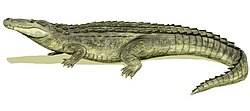| Kuttanacaiman | |
|---|---|
| Scientific classification | |
| Kingdom: | Animalia |
| Phylum: | Chordata |
| Class: | Reptilia |
| Clade: | Archosauria |
| Order: | Crocodilia |
| Family: | Alligatoridae |
| Subfamily: | Caimaninae |
| Genus: | † Kuttanacaiman Salas-Gismondi et al., 2015 |
| Type species | |
| †Kuttanacaiman iquitosensis Salas-Gismondi et al., 2015 | |
Kuttanacaiman is a monotypic genus of extinct caiman represented by the type species Kuttanacaiman iquitosensis. Kuttanacaiman lived in what is now the Amazon basin during the Middle Miocene, approximately 13 million years ago (Ma). The species was named in 2015 on the basis of one nearly complete skull and a second partial skull from the Pebas Formation near Iquitos, Peru. K. iquitosensis is characterized by a short, rounded snout and blunt teeth at the back of its jaws that were likely adapted to crushing freshwater bivalves. Its estimated total body length is 171.2 to 189.1 centimetres (5.62 to 6.20 ft). [1]
Contents



